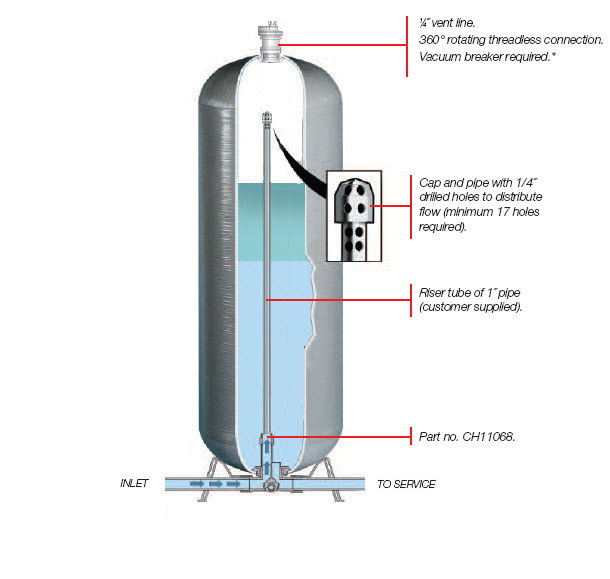“What is a CT Value?”: The (Simple) Math Behind Water Disinfection

Disinfection of your water is crucial to ensuring that your water is safe to drink and free of harmful bacteria and other organisms. The primary methods of disinfection chlorination, hydrogen peroxide injection, ozone, and UV light. All of these methods, however, require sufficient contact time between the water and the disinfectant.
Proper contact time must also be complemented by the correct dosage of a disinfectant; multiplying the concentration of your disinfectant by the time of contact with your water will give you a CT value. See the formula below for calculating CT when using chlorine:
CT = Concentration of free chlorine (C mg/L) * contact time (T Minutes)
where
Free chlorine = Concentration measured in milligrams per liter (mg/L)

Since different contaminants require different CT values for complete disinfection, it’s important that you find the right amounts of disinfectant and contact time needed to adequately disinfect your water. Note that higher concentrations of disinfectants are required when contact time is shorter; for this reason, longer contact times are preferable.
Now that you know how to calculate your CT value, consult the charts below to find out precisely what value you’ll need to disinfect your water based on its condition and its contaminants. Note that a 3 log removal means 99.9% removal rate, while a 4-log removal will remove 99.99% of viruses/bacteria.
U.S. EPA CT VALUES (mg/L x min) for the Inactivation of Giardia Cysts with Ozone at Different Temperatures and pH from 6 to 9. Temperature °C (°F)
| Inactivation | 0.5(32.1) | 5(41) | 10(50) | 15(59) | 20(68) | 25(77) |
| 0.5 log | 0.48 | 0.32 | 0.23 | 0.16 | 0.12 | 0.08 |
| 1.0 log | 0.97 | 0.63 | 0.48 | 0.32 | 0.24 | 0.16 |
| 1.5 log | 1.50 | 0.95 | 0.72 | 0.48 | 0.36 | 0.24 |
| 2.0 log | 1.90 | 1.30 | 0.95 | 0.63 | 0.48 | 0.32 |
| 2.5 log | 2.40 | 1.60 | 1.20 | 0.79 | 0.60 | 0.40 |
| 3.0 log | 2.90 | 1.90 | 1.40 | 0.95 | 0.72 | 0.48 |
CT Values for Inactivation of Viruses by Ozone Temperature, °C
| Inactivation | <1 |
5 |
10 |
15 |
20 |
25 |
| 2‐ log | 0.48 | 0.32 | 0.23 | 0.16 | 0.12 | 0.08 |
| 3‐ log | 0.97 | 0.63 | 0.48 | 0.32 | 0.24 | 0.16 |
| 4‐ log | 1.50 | 0.95 | 0.72 | 0.48 | 0.36 | 0.24 |
CT Values for 3‐log (99.9%) Inactivation of Giardia Cysts by Free Chlorine at Water Temperature 10.0 °C (50°F)
| Free Residual, Mg/L |
pH < 6.0 |
pH 6.5 |
pH 7.0 |
pH 7.5 |
pH 8.0 |
pH 8.5 |
pH < 9.0 |
| < 0.4 |
73 |
88 |
104 |
125 |
149 |
177 |
209 |
| 0.6 |
75 |
90 |
107 |
128 |
153 |
183 |
218 |
| 0.8 |
78 |
92 |
110 |
131 |
158 |
189 |
226 |
| 1.0 |
79 |
94 |
112 |
134 |
162 |
195 |
234 |
| 1.2 |
80 |
95 |
114 |
137 |
168 |
200 |
240 |
| 1.4 |
82 |
98 |
116 |
140 |
170 |
206 |
247 |
| 1.6 |
83 |
99 |
119 |
144 |
174 |
211 |
253 |
| 1.8 |
88 |
101 |
122 |
147 |
179 |
215 |
259 |
| 2.0 |
87 |
104 |
124 |
150 |
182 |
221 |
265 |
| 2.2 |
89 |
105 |
127 |
153 |
186 |
225 |
271 |
| 2.4 |
90 |
107 |
129 |
157 |
190 |
230 |
276 |
| 2.6 |
92 |
110 |
131 |
160 |
194 |
234 |
281 |
| 2.8 |
93 |
111 |
134 |
163 |
197 |
239 |
287 |
| 3.0 |
95 |
113 |
137 |
166 |
201 |
243 |
292 |
Now you're ready to start disinfecting. Later this week we'll discuss the various disinfection methods and treatment systems available to homeowners. Until then, you can e-mail us at [email protected] with any questions. Thanks for reading!














